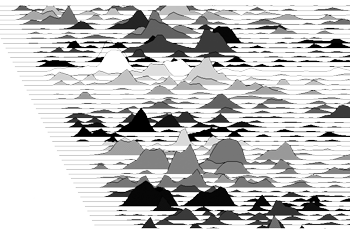Hardware and algorithmic features of radiation, reception and processing of signals using incoherent scatter technique
DOI:
https://doi.org/10.3103/S0735272722120056Abstract
The paper considers the variants of improving the operation modes of high-power ground-based means of near-Earth space remote sensing, i.e., radars that employ the method of incoherent scattering (IS) of radiowaves in ionospheric plasma. Examples of experimental results of obtaining values of the electron concentration in ionosphere using the measurement of height power distribution of IS signal and its processing are presented. The functional block-diagrams of IS radar for different operation modes, in particular using the orthogonal excitation antenna dipoles and ring bridge, were also presented. Peculiarities of radiation and reception of radiowaves with both linear and circular polarization are considered. In the first case, the effect of Faraday rotation of radiowave polarization plane is used that causes typical IS signal fading when this signal is received by the linearly polarized antenna and consequently fluctuations in the height power profile of IS signal and also in the function obtained by processing the orthogonal components of signal that is used for the calculation of electron concentration. In the second case, the values of electron concentration are obtained by using the profile of IS signal power, in which the impact of the Faraday effect is eliminated. The results of conducted experiments simultaneously for the upper and lower ionosphere are presented including the calculation of concentration of ionospheric plasma electrons with sufficient height resolution dependent on the duration of elements of composed probing signal. The radiation mode of two-element radio-pulse with the direction change of polarized wave rotation has been proposed for simultaneous measuring of ionosphere parameters in a wide range of heights.
References
- J. V. Evans, “Theory and practice of ionosphere study by Thomson scatter radar,” Proc. IEEE, vol. 57, no. 4, pp. 496–530, 1969, doi: https://doi.org/10.1109/PROC.1969.7005.
- V. I. Taran, “A study of the natural and artificially disturbed ionosphere by the incoherent scatter method,” Geomagn. Aeron., vol. 41, no. 5, pp. 632–639, 2001, uri: https://www.researchgate.net/publication/288606253_A_study_of_the_natural_and_artificially_disturbed_ionosphere_by_the_incoherent_scatter_method.
- V. I. Taran, “Observations of ionosphere using the incoherent scattering method. Message 1. Main prerequisites and experimental results,” Vestn. KhPI, vol. 155, no. 1, pp. 3–12, 1979.
- A. Miroshnikov, V. Pulyayev, L. Emelyanov, E. Rogozhkin, “Determination of the incoherent scatter signal statistical characteristics,” in 2019 IEEE 39th International Conference on Electronics and Nanotechnology (ELNANO), 2019, pp. 774–777, doi: https://doi.org/10.1109/ELNANO.2019.8783823.
- D. T. Farley, “Incoherent scatter correlation function measurements,” Radio Sci., vol. 4, no. 10, pp. 935–953, 1969, doi: https://doi.org/10.1029/RS004i010p00935.
- V. I. Taran, “Investigation of ionosphere using an incoherent scattering radar in Kharkiv,” Vestn. KhPI, no. 31, pp. 3–9, 1999.
- G. H. Millman, A. J. Moceyunas, A. E. Sanders, R. F. Wyrick, “The effect of Faraday rotation on incoherent backscatter observations,” J. Geophys. Res., vol. 66, no. 5, pp. 1564–1568, 1961, doi: https://doi.org/10.1029/JZ066i005p01564.
- G. H. Millman, V. C. Pineo, D. P. Hynek, “Ionospheric investigations by the faraday rotation of incoherent backscatter,” J. Geophys. Res., vol. 69, no. 19, pp. 4051–4065, 1964, doi: https://doi.org/10.1029/JZ069i019p04051.
- D. T. Farley, J. P. McClure, D. L. Sterling, J. L. Green, “Temperature and composition of the equatorial ionosphere,” J. Geophys. Res., vol. 72, no. 23, pp. 5837–5851, 1967, doi: https://doi.org/10.1029/JZ072i023p05837.
- D. T. Farley, “Faraday rotation measurements using incoherent scatter,” Radio Sci., vol. 4, no. 2, pp. 143–152, 1969, doi: https://doi.org/10.1029/RS004i002p00143.
- J. M. Goodman, “Traveling ionospheric disturbances observed through use of a Thomson scatter technique employing Faraday rotation at 140 MHz,” J. Atmos. Terr. Phys., vol. 33, no. 11, pp. 1763–1777, 1971, doi: https://doi.org/10.1016/0021-9169(71)90222-4.
- E. I. Grigorenko, “Investigation of the ionosphere based on observations of Faraday’s effect at incoherent scattering of radio waves,” Ionos. Issled., vol. 27, pp. 60–73, 1979.
- T. A. Skvortsov, L. Y. Yemelyanov, A. V. Fisun, “Radar measurements of geomagnetic field in the ionosphere,” Telecommun. Radio Eng., vol. 74, no. 10, pp. 921–931, 2015, doi: https://doi.org/10.1615/TelecomRadEng.v74.i10.80.
- R. Flores, M. Milla, K. Kuyeng, “Spectral analysis of incoherent scatter radar signals in Faraday/double pulse experiments at the Jicamarca radio observatory,” in 2021 IEEE International Conference on Aerospace and Signal Processing (INCAS), 2021, pp. 1–4, doi: https://doi.org/10.1109/INCAS53599.2021.9666925.
- L. Emelyanov, E. Rogozhkin, V. Pulyayev, “Features of reception of signals with linear and circular polarization in the incoherent scatter technique,” in 2022 IEEE 41st International Conference on Electronics and Nanotechnology (ELNANO), 2022, pp. 529–534, doi: https://doi.org/10.1109/ELNANO54667.2022.9927099.
- V. O. Puliaev, Y. V. Rogozhkin, O. V. Bogomaz, Computational Procedures in Analyzing the Incoherent Scattering in Ionospheric Plasma. Kharkiv: NTU “KhPI,” 2013.
- V. F. Fusco, Microwave Circuits: Analysis and Computer-Aided Design. Prentice Hall, 1986, uri: www.amazon.com/Microwave-Circuits-Analysis-Computer-Aided-Design/dp/0135815886.
- Z. Ding, J. Wu, Z. Xu, B. Xu, L. Dai, “The Qujing incoherent scatter radar: system description and preliminary measurements,” Earth, Planets Sp., vol. 70, no. 1, p. 87, 2018, doi: https://doi.org/10.1186/s40623-018-0859-8.
- W. J. G. Beynon, P. J. S. Williams, “Incoherent scatter of radio waves from the ionosphere,” Reports Prog. Phys., vol. 41, no. 6, pp. 909–955, 1978, doi: https://doi.org/10.1088/0034-4885/41/6/003.
- N. Wichaipanich, P. Supnithi, T. Tsugawa, T. Maruyama, “Thailand low and equatorial F2-layer peak electron density and comparison with IRI-2007 model,” Earth, Planets Sp., vol. 64, no. 6, pp. 485–491, 2012, doi: https://doi.org/10.5047/eps.2011.01.011.
- D. T. Farley, “Multiple-pulse incoherent-scatter correlation function measurements,” Radio Sci., vol. 7, no. 6, pp. 661–666, 1972, doi: https://doi.org/10.1029/RS007i006p00661.
- V. N. Pochernyaev, “A ring-shaped bridge in partially filled rectangular waveguides,” Radioelectron. Commun. Syst., vol. 48, no. 5, pp. 57–60, 2005, doi: https://doi.org/10.3103/S0735272705050110.
- I. V. Horbatyi, “Radio frequency 4-channel 0-360° range digitally controlled phase shifter for telecommunication systems with amplitude modulation of many components,” Radioelectron. Commun. Syst., vol. 65, no. 5, pp. 248–257, 2022, doi: https://doi.org/10.3103/S073527272205003X.


